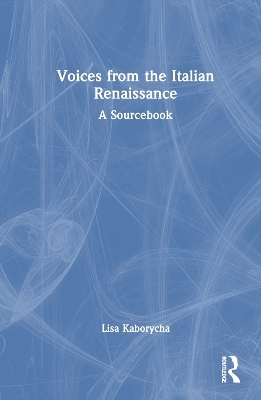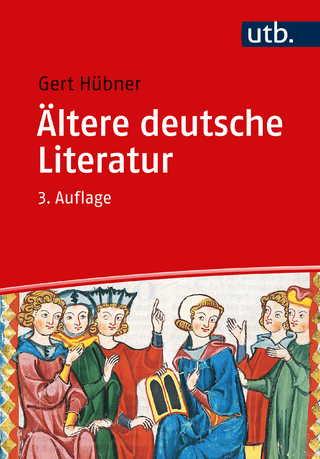
Voices from the Italian Renaissance
Routledge (Verlag)
978-1-032-25627-6 (ISBN)
- Titel z.Zt. nicht lieferbar
- Versandkostenfrei innerhalb Deutschlands
- Auch auf Rechnung
- Verfügbarkeit in der Filiale vor Ort prüfen
- Artikel merken
The Italian Renaissance was a period of intense cultural transformations when the ancient world was being rediscovered and a New World had been literally discovered. Between the thirteenth and the seventeenth centuries, traditional beliefs were being challenged as people across the Italian Peninsula explored new ways of thinking about religion, politics, and society and introduced startling innovations in the arts.
This book contains more than hundred selections of primary sources—the historian’s raw material in the form of memoirs, letters, treatises, sermons, stories, poems, drawings, paintings, and sculpture. Here are eyewitness accounts of cold-blooded murders, lavish court pageants, the Sack of Rome, and the Black Death; first views of Michelangelo’s Sistine frescoes and glimpses of the surface of the moon through Galileo’s telescope. These sources bring the reader into direct contact with the creators of the great Renaissance works of art, literature, philosophy, and science, as well as lesser-known people, who in their own words express emotions of love, loss, and spiritual yearning.
Selected to accompany and supplement A Short History of Renaissance Italy, the primary sources in this book make it an ideal course reader for students of history or art history. Yet this volume can be equally read well on its own; each selection is clearly introduced, annotated, and provided with references for further reading. These sources reach out to an audience beyond the classroom—the general reader, or the traveler to Italy—anyone curious to learn more about the Italian Renaissance will find themselves swept into conversation with these vibrant voices from the past.
Lisa Kaborycha holds a Ph.D. in medieval and early modern European history from the University of California, Berkeley and has been the recipient of a Fulbright Fellowship, a National Endowment for the Humanities Fellowship with the Medici Archive Project, and Harvard’s Villa I Tatti Fellowship in Italian Renaissance Studies. In addition to A Short History of Renaissance Italy (2023), she is the author of A Corresponding Renaissance: Letters Written by Italian Women, 1375-1650 (2016). For years, Kaborycha taught courses in Renaissance history for the University of California and currently works as adjunct professor at the University of New Haven Tuscany Campus and lecturer at the British Institute of Florence.
Preface
PART I: The natural world
1 Expressing reverence for all of creation
2 Giotto and the birth of “modern” art
3 A river, a mountain, a young man’s soul
4 A city manages a natural disaster
5 Nature triumphs over nurture
6 Leonardo takes a close look at plants
7 How to create a realistic monster
8 Likenesses in art and in art history
9 Heretical belief in a “world soul”
10 A scientist’s method of observation
PART II: Under the infuence of the ancients
11 Rival humanists fght a war of words
12 Antiquity as inspiration for painters
13 Philology deployed against the papacy
14 The duke of Milan likened to Caesar
15 A triumphal arch for the king of Naples
16 Man’s unique place in the cosmos
17 Women’s place among humanists
18 A plea for architectural conservation
19 Benefts of civil strife in ancient Rome
20 Ancient fragmented statues speak
PART III: The sacred and the secular
21 The pope asserts supreme authority
22 A scholar denies secular power of papacy
23 A cardinal’s lavish party in Avignon
24 A holy woman urges the pope to reform
25 Papal patronage, largesse, and nepotism
26 Accounts of the 1527 Sack of Rome
27 The characters of two popes compared
28 Art, both sacral and sensuous
29 An artist feshes out religious doctrine
30 Religious diversity promoted in Tuscany
PART IV: The arts in social context
31 Painting as profession, craft, and art
32 Sculptors in corporation and in combat
33 The patronage of Cosimo de’ Medici
34 A masterpiece in a friar’s cell
35 An artist seeks employment at court
36 Two ladies consider a portrait
37 Networks of musical patronage
38 Titian, his patron, and his guests
39 Perseus and his heroic sculptor
40 The performance of a renowned actor
PART V: Loves, ideal and real
41 The notary who invented the love sonnet
42 A mystic marriage with Christ
43 A record of life’s loves and sorrows
44 Two extramarital encounters described
45 Venus triumphs at the court in Ferrara
46 Philosophers’ handbooks on love
47 A spiritual and earthly object of desire
48 A poet’s amorous raptures and torments
49 Love afairs of the Olympian gods
50 An artist’s love for a younger man
PART VI: Politics and statecraft
51 The doge, embodiment of the state
52 Political discord in communal Italy
53 A deadly attack on the Medici family
54 A sermon on Florentine political reform
55 Cesare Borgia’s assassinations
56 How the courtier ought to serve his prince
57 Praise for the Venetian constitution
58 Envisioning a queenly republic
59 Emperor Charles V in Italy
60 Art, luxury, and gifts in diplomacy
PART VII: Domestic life, family, society
61 A merchant criticized by his wife
62 A Venetian noble’s marriage advice
63 A saint’s stepmother fles her taxes
64 A friar preaches civic and domestic peace
65 Managing matters of life, death, dowry
66 A playwright stages scenes from life
67 The professional life of a courtesan
68 Venetian ladies discuss marriage
69 A lovely child remembered
70 Sexual abuse in art and in life
PART VIII: Travel, curiosity, and wonder
71 A medieval Jewish traveler in Italy
72 Marco Polo marvels at paper money
73 A merchant’s literal and literary voyages
74 Claiming and renaming a wondrous land
75 A Florentine invents America
76 Poet, artist, and scientist explore the Moon
77 Belief in witches or in a new world?
78 The marvelous city of Fez described
79 A strange and wonderful museum
80 Discovery of an ideal, “nowhere” city
| Erscheinungsdatum | 27.03.2024 |
|---|---|
| Zusatzinfo | 34 Halftones, black and white; 34 Illustrations, black and white |
| Verlagsort | London |
| Sprache | englisch |
| Maße | 156 x 234 mm |
| Gewicht | 990 g |
| Themenwelt | Geschichte ► Allgemeine Geschichte ► Mittelalter |
| Geschichte ► Allgemeine Geschichte ► Neuzeit (bis 1918) | |
| Geisteswissenschaften ► Geschichte ► Regional- / Ländergeschichte | |
| Geschichte ► Teilgebiete der Geschichte ► Kulturgeschichte | |
| ISBN-10 | 1-032-25627-3 / 1032256273 |
| ISBN-13 | 978-1-032-25627-6 / 9781032256276 |
| Zustand | Neuware |
| Haben Sie eine Frage zum Produkt? |
aus dem Bereich


